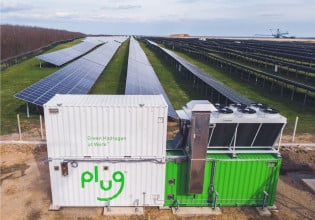Wooden Wind Turbines: A More Sustainable Alternative to Steel?
Sweden’s power grid is now being supported by the tallest wooden wind turbine in the world. While wood is not the typical material for turbine construction, this project demonstrates its viability and advantages.
Solar innovation often outpaces other renewables, but more cutting-edge developments transform the wind power sector daily. Engineers are exploring material options for wind turbine towers and blades. Modvion, a Swedish startup, has just launched the tallest wooden wind turbine in the world, and they are exploring how this organic material can offer key performance advantages.
Assembling a wooden wind turbine. Image used courtesy of Modvian
The lightweight spruce facilitates rotation to maximize power and offers critical environmental advantages, including reuse potential and carbon absorption. Perhaps most importantly, wood turbines can be broken down into parts and reassembled on-site, easing transportation challenges.
The Disadvantages of Steel Wind Turbines
The relationship between performance and equipment material is complex and determined by factors such as material cost, supply chain availability, longevity, and environmental sustainability, which is now a critical concern given tightening government regulation. The case is no different for wind turbines, and the material used for both the tower and blades is critical for efficiency and long-term viability.
The industry standard for wind turbine material is steel. According to the National Renewable Energy Laboratory, 66-79% of typical turbine models are made of steel. Other materials, including fiberglass, plastic, and resin, comprise the remaining components.
Steel has obvious advantages, or it never would have dominated the industry as the primary material for turbine construction. The strength of steel makes it ideal for equipment longevity, and a well-established steel supply chain ensures that manufacturers can maintain uninterrupted production.
Yet, some steel drawbacks remain, including the shipping and transportation of the turbine itself. The U.S. Department of Energy is still researching solutions such as flexible blades, which could mitigate some transport challenges. Since current turbine parts cannot be bent, disassembled, or compressed after being manufactured, serious obstacles occur in basic trucking infrastructure, like overpass heights and the radius needed to turn safely when moving an object this large.
Height of wind turbines over time. Image used courtesy of Department of Energy
The simple and inescapable correlation between size and power output also compounds this issue. The larger the blades, the greater the amount of electricity produced, so shrinking blades and towers for easier transport compromises basic functionality.
Wood Wind Turbine Specs and Performance Advantages
Modvion’s innovative reimagining of a seemingly obsolete material option is already powering homes in Sweden. Including the blades, the current model stands at 150 meters tall, the tower has 144 layers of laminated veneer lumber, and it can power up to 400 homes.
The design of the wooden turbine also removes the transport problem common with steel turbines since steel parts cannot be compressed or bent after they are manufactured. To assemble the modular wood turbines, workers connect 28 pieces linked with steel fittings. Breaking down the design into component parts makes shipping significantly easier.
Modvian wood turbine. Image used courtesy of Modvian
Using wood as the primary material for wood turbines, sometimes called timber turbines, also brings significant environmental benefits. Experts calculate the manufacturing process would be considered carbon neutral because the carbon-storing capacity of the trees supplying the material offsets the carbon emissions associated with other phases of the manufacturing process. For every wooden tower manufactured, approximately 2,000 tonnes of carbon emissions will be saved.
Using wood for modern equipment or structures might seem quaint or anachronistic, but Modvion’s wooden wind turbine demonstrates that innovation sometimes requires a return to the past. For applications such as offshore wind farms, wood can even outperform steel, which suffers in maritime environments. With modern tools and technologies, wood can be used in surprising ways, thus prompting reconsideration of wood’s inherent potential as a modern material option.









